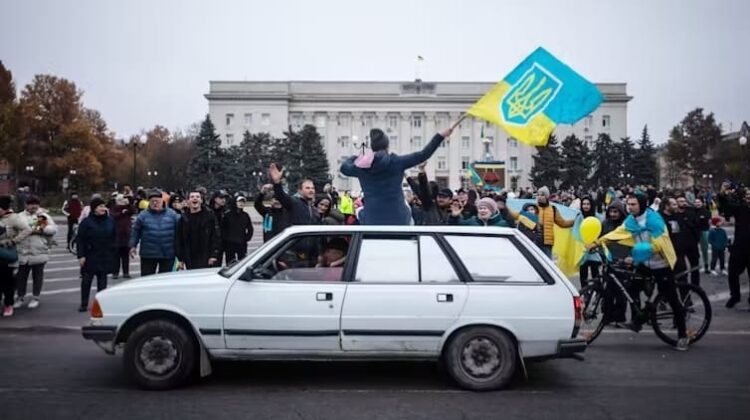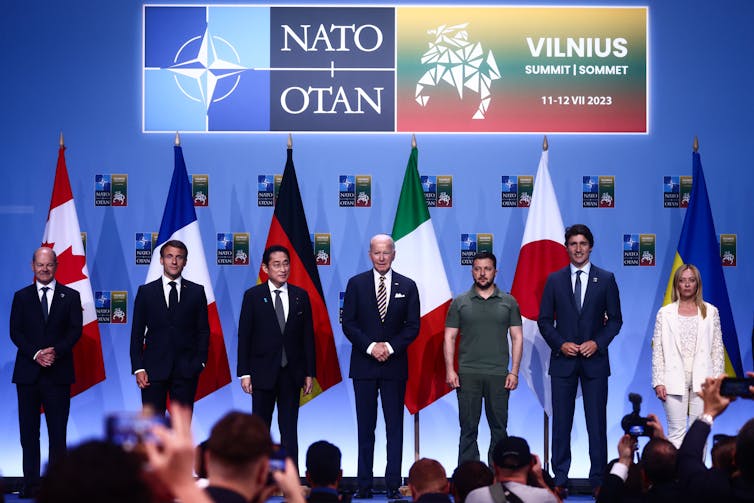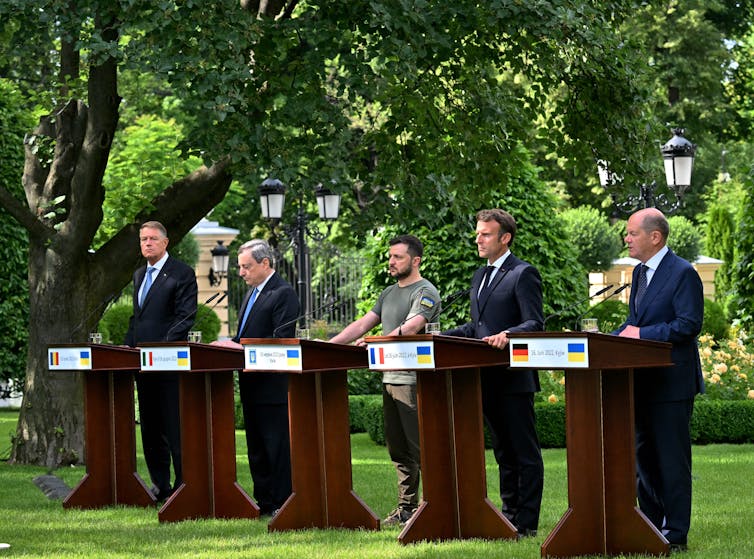
Ukraine’s push for NATO membership is rooted in its European past – and its future
Ukrainians celebrate on Nov. 12, 2022, in Kherson, Ukraine, after Ukraine regained control of the city. Yevhenii Zavhorodnii/Global Images Ukraine via Getty Images
Kateryna Shynkaruk, Texas A&M University
During a recent meeting with the nation’s diplomatic corps, President Volodymyr Zelenskyy gave Ukraine’s ambassadors their marching orders for the rest of the year: Work to help secure Ukraine’s membership in the North Atlantic Treaty Organization and the European Union. Zelenskyy also told the ambassadors to focus on helping Ukraine secure bilateral agreements for security guarantees between Ukraine and individual G7 countries, including the United States.
“The task of ambassadors to NATO countries is to work to consolidate all the capitals of the Alliance around common security priorities,” he said. “It is in Ukraine that security for our continent and for the rules-based international order as a whole is being gained, and this deserves political and legal recognition by all our allies.”
Zelenskyy held the August 2023 meeting with ambassadors three weeks after leaving the NATO summit in Vilnius, Lithuania, without the timetable for Ukraine to join the alliance that he wanted.
In some ways, Zelenskyy is steering Ukraine through a war on two fronts. There is the hot counteroffensive the country is waging against Russia in its own cities, villages and towns. And there is its long fight to be a formal part of the West through inclusion in NATO and the EU. The latter fight is not just about Ukraine’s desire for long-term security. It is also about its geopolitical identity.
NATO members promised in a July 11, 2023, communiqué during the alliance’s two-day summit in Vilnius that Ukraine could join NATO “when Allies agree and conditions are met.” Although the communiqué acknowledged Ukraine did not need to follow the alliance’s membership action plan, it lacked specific steps Ukraine must take to receive an invitation for membership.
The lack of specifics caught Zelenskyy’s attention and he tweeted, “It’s unprecedented and absurd when [a] time frame is not set neither for the invitation nor for Ukraine’s membership. While at the same time vague wording about ‘conditions’ is added even for inviting Ukraine.”
Some leaders were reportedly stunned by Zelenskyy’s public criticism.
As a scholar of international relations, Ukrainian politics and European security, I have studied and taught about how Ukraine’s geopolitical and ideological moves away from Russia have developed since the fall of the Soviet Union and how its policy decisions have often depended on the status of its relationship with Russia, the EU and the U.S. I have also studied how Ukraine might follow the examples of other countries to gain membership in Western alliances.
Zelenskyy, like a majority of Ukrainians, views Ukraine as ideologically and geopolitically separate from Russia.

Ukraine’s movement to the West
Before the collapse of the Soviet Union in 1991, Ukraine was its second-most populous republic, after Russia. And Ukraine had the USSR’s third-largest nuclear arsenal. But since the collapse, Ukraine has worked to separate from Russia and move toward the West, seeking national security and economic growth by realigning itself ideologically and politically with Europe.
Over the years, there have been many steps toward the West and some away from it.
In 1994, Ukraine joined the NATO Partnership for Peace program and through it worked with the alliance to fight corruption in Ukraine’s military, improve its military training and get other countries to take its excess and obsolete weapons. This showed that a post-Soviet Ukraine was willing to work with NATO even when membership was not an option.
During the 1990s and 2000s, NATO and the EU admitted some of Ukraine’s neighbors from post-communist Europe and post-Soviet Baltic, leaving Russian President Vladimir Putin to view the few countries that were left outside of these alliances – Ukraine, Georgia and Moldova – as without protection from the West.
The 2004 presidential contest between then Prime Minister Viktor Yanukovych and Viktor Yushchenko, a former prime minister, was marred by such widespread allegations of election tampering by the Yanukovych campaign that it sparked a series of peaceful protests. Known as the Orange Revolution, these protests against electoral fraud were followed by a December 2004 election rerun. Ukrainians elected pro-Western Yushchenko president.
Ukraine’s transition is not smooth
At the April 2008 NATO summit in Bucharest, Romania, member nations agreed that Ukraine and Georgia would become members of NATO. But the alliance suggested conditions, including democratic reforms in both countries, with no clear plan for achieving those reforms.
In 2010, Yanukovych, who campaigned on a promise to keep Ukraine out of NATO, was elected president. Once in office, he abolished a commission that had been established to help Ukraine integrate with NATO. In 2013, Yanukovych ended discussions between Ukraine and the EU for a political and trade deal known as an association agreement. That decision sparked protests in Kyiv and around the country.
That protest, the Euromaidan Revolution, also known as the Revolution of Dignity, lasted until February 2014 and forced the Kremlin-aligned Yanukovych to flee to Russia. By March 2014, Russia had annexed Crimea and invaded the eastern Donetsk and Luhansk regions of Ukraine in April with help from Russian-backed separatists.
Following these aggressions by Russia, a November 2015 nationwide poll showed 57% of the Ukrainian citizens queried favored joining the EU, and 48% favored joining NATO.
In 2014, Ukraine eventually signed a deal with the EU that included a new comprehensive free trade agreement. That was followed in 2017 by a visa agreement that allowed Ukrainians visa-free travel to the EU for 90 days every six months.

Ukraine’s geopolitical identity
Putin, still angry about the collapse of the Soviet Union, ordered an invasion of Ukraine in February 2022. He claimed Russia needed to “demilitarize and denazify” the country.
Regardless of what Putin says were his motives, many security analysts maintain the invasion was possible because Ukraine and Georgia, which Russia attacked in 2008, had no protection. The two nations were not part of a Western alliance such as NATO or the EU.
When Russia invaded Ukraine, Zelenskyy looked to the West for help. On the third day of the invasion, he applied for Ukraine’s EU membership. And on Sept. 30, 2022, he applied for Ukraine’s membership in NATO. Ukrainians overwhelmingly support that decision. A February 2023 poll showed 83% of the people surveyed said Ukraine should join NATO.
By June 2023, the EU’s leaders had determined that Ukraine had met two of seven conditions required for the country to begin membership talks. One condition concerns judicial reform, and the other is about its standards in media law. The country is making “good progress” on the third and “some progress” on the remaining four conditions, including the fight against corruption, said Olivér Várhelyi, the EU’s commissioner for enlargement.
Although Ukraine hasn’t joined NATO yet, Zelenskyy’s push for membership is part of a long-term goal for Ukraine to gain security from Russia. The country has never attacked a member of NATO or the EU.
Kateryna Shynkaruk, Senior Lecturer of International Relations, Texas A&M University
This article is republished from The Conversation under a Creative Commons license. Read the original article.
